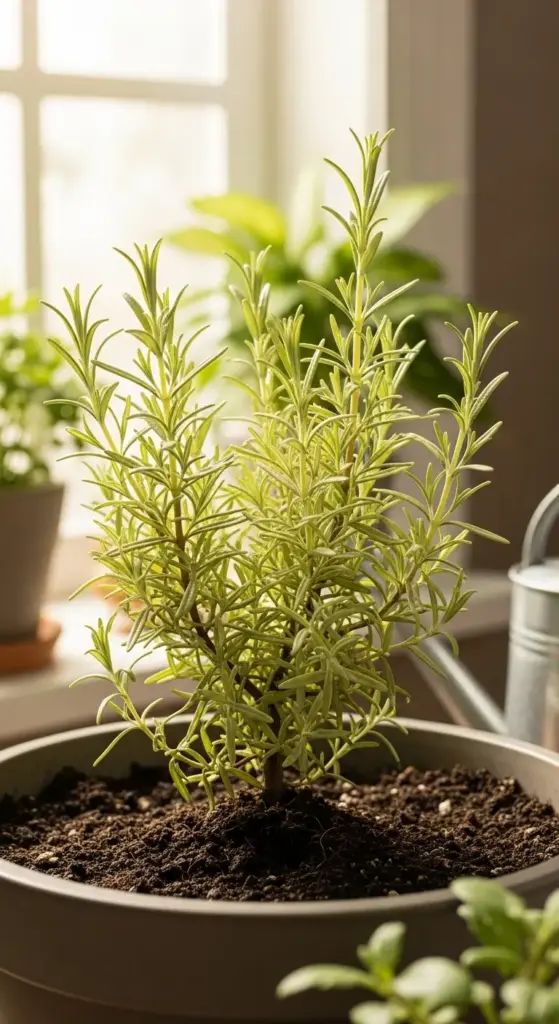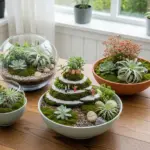6. Stunted Growth and Pale Green Coloring

I stared at my sad little rosemary plant for months, wondering why it looked like it had given up on life. The pale green coloring made it look sickly, and after six months, it was barely bigger than when I first brought it home.
I was doing everything “right” – watering carefully, giving it a sunny spot, even talking to it occasionally. But something was clearly wrong, and I had no idea what.
Nutrient Deficiency Signs Specific to Rosemary Plants
Rosemary nutrient deficiency shows up differently than in other herbs, and it took me forever to figure this out. Most plants get yellow leaves when they’re hungry, but rosemary gets this weird, washed-out pale green color instead.
Nitrogen deficiency is the most common culprit. The leaves lose that rich, silvery-green color and start looking almost lime-colored. New growth comes in looking weak and spindly.
Phosphorus deficiency is sneakier – the plant just stops growing without much visual change at first. Then you notice the leaves are smaller than they should be and have this dull, lifeless appearance.
Iron deficiency shows up as yellowing between the leaf veins while the veins themselves stay green. I thought this was normal rosemary coloring until I saw a healthy plant and realized mine looked nothing like it.
Magnesium deficiency causes older leaves to yellow from the edges inward, but the yellowing has this distinctive pale quality that’s different from overwatering damage.
How Container Size Limits Growth Potential
This was my biggest “aha” moment. I had my rosemary in this cute little 4-inch pot for over a year, wondering why it wasn’t thriving like the pictures I saw online.
Root-bound rosemary basically goes on a growth strike. The roots circle around and around in the pot with nowhere to go, and the plant just… stops. No new growth, pale leaves, the whole sad package.
I finally unpotted my struggling plant and found roots so tightly wound they looked like a bird’s nest. No wonder the poor thing couldn’t grow!
Container size directly affects how big your rosemary can get. A 4-inch pot will keep your plant tiny forever. A 6-8 inch pot allows for decent growth, but if you want a full-sized herb plant, you need at least 10-12 inches.
The root-to-pot ratio should be about 1:1. If your plant’s root ball takes up more than 80% of the pot space, it’s time to size up.
Light Requirements for Indoor vs. Outdoor Growing
Indoor rosemary lighting was where I made my biggest mistakes. I thought a bright windowsill would be enough, but rosemary needs way more light than most houseplants.
South-facing windows are your best bet indoors, but even then, you’re probably not getting enough light during winter months. I learned this after my plant basically went dormant from October to March.
Outdoor rosemary needs at least 6-8 hours of direct sunlight daily. Anything less and you get that pale, stretched-out growth that looks nothing like the robust plants you see in garden centers.
Grow lights became my winter savior. I use a full-spectrum LED about 12 inches above my rosemary for 12-14 hours daily during the dark months.
Light deficiency causes that characteristic pale coloring and weak, spindly growth. The plant stretches toward whatever light it can find, creating these long, weak stems with sparse leaves.
The Nitrogen-Phosphorus Balance Rosemary Needs
Getting the nutrient balance right for rosemary is tricky because it’s not like feeding tomatoes or roses. These Mediterranean plants prefer lean conditions, but they still need some nutrition.
Too much nitrogen creates lush, soft growth that’s more susceptible to pests and diseases. I learned this after over-fertilizing and ending up with aphid problems.
Too little nitrogen gives you that pale, stunted growth I was dealing with. The plant can’t produce enough chlorophyll to maintain that rich green color.
Phosphorus is crucial for root development and overall plant health, but rosemary doesn’t need huge amounts. A balanced fertilizer used at half strength works better than high-nitrogen plant foods.
The NPK ratio I’ve had the best luck with is something like 10-10-10 or 5-5-5, used very sparingly. Rich, high-nitrogen fertilizers designed for leafy greens are usually too strong.
When and How to Transplant to a Larger Container
Transplanting timing matters more than I realized. I used to repot whenever I felt like it, which usually meant stressed plants and poor results.
Spring transplanting works best, right when you start seeing new growth. The plant has the whole growing season ahead to establish in its new container.
Never transplant during winter unless it’s an absolute emergency. Dormant plants don’t recover well from root disturbance.
Signs it’s time to repot: roots growing out of drainage holes, water running straight through without being absorbed, or the plant becoming top-heavy and tipping over easily.
Transplanting technique is crucial. I gently tease apart those circled roots – they won’t straighten out on their own. Sometimes I have to be pretty aggressive about breaking up the root ball.
New container size should only be 1-2 inches larger in diameter than the old one. Going too big creates the same waterlogging problems I dealt with earlier.
Fresh potting mix is essential. Don’t try to save money by reusing old soil – your plant needs fresh nutrients and proper drainage to establish in its new home.
Post-transplant care means backing off on watering for the first week or two. The roots need time to grow into the new soil before they can handle normal watering schedules.
I always place newly transplanted rosemary in bright, indirect light for a few days before moving it back to its sunny spot. Think of it as recovery time after surgery.
Fertilizer timing after repotting should wait at least 4-6 weeks. Fresh potting soil usually has enough nutrients to get the plant established, and fertilizing too soon can burn newly developing roots.
Think you’ve got all the big problems covered? Click “next” to discover the tiny invaders that might already be living on your rosemary – and why that magnifying glass app on your phone could save your entire herb garden!









GIPHY App Key not set. Please check settings